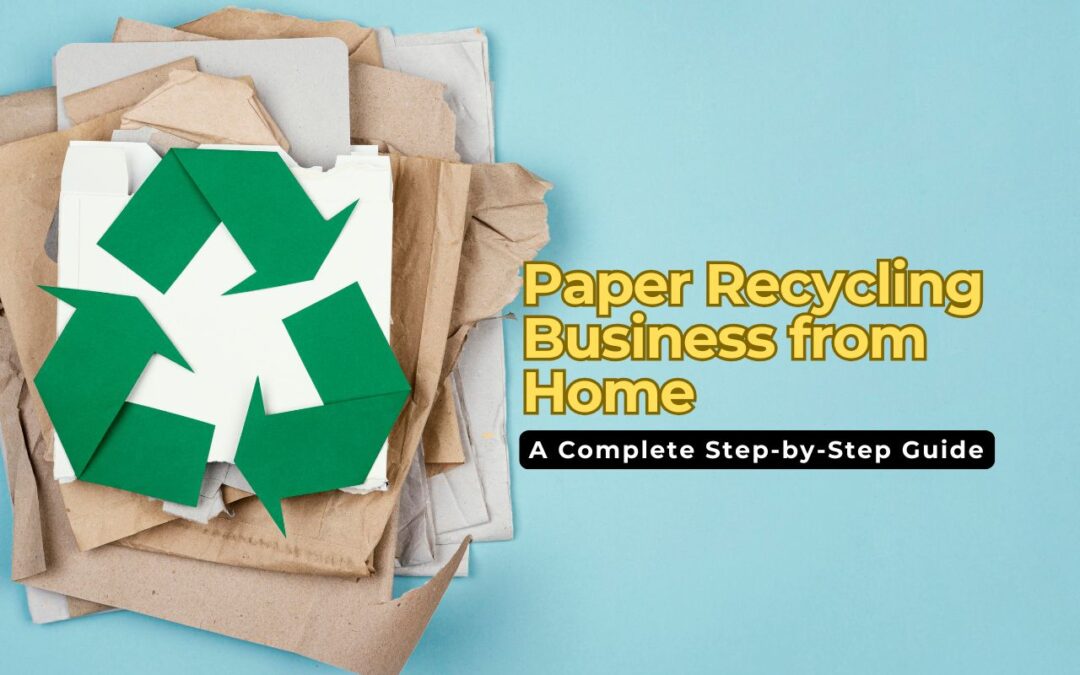In an era where sustainability is more than just a buzzword, launching a paper recycling business from home isn’t just an environmentally conscious decision—it’s also a profitable one. With the rising concern over deforestation, landfill waste, and environmental degradation, communities and businesses alike are searching for greener solutions. Starting a home-based paper recycling business puts you in a unique position to meet this demand while reducing waste and making a positive impact.
This guide will walk you through everything you need to know to launch a successful paper recycling business from home, step by step. From setting up your workspace to finding customers and scaling your operations, let’s dive into the green goldmine waiting for you.
Why Start a Paper Recycling Business from Home?
1. Low Startup Costs
Unlike manufacturing or tech startups, a paper recycling business doesn’t need a big budget to start. You can begin with simple tools, a garage, and a passion for the environment.
2. Earn While You Save the Planet
You’re not just collecting and processing waste—you’re turning it into a commodity. Whether it’s recycled paper pulp, handmade paper products, or shredded paper for packaging, each form of recycled paper has a market.
3. Work from the Comfort of Your Home
No need to rent office space or warehouses. Your home can be a fully functioning mini recycling hub with a bit of creativity and planning.
Step 1: Understand the Paper Recycling Industry
Before jumping in, get a clear understanding of how paper recycling works. The basic cycle involves:
- Collection – Gathering used paper from homes, schools, offices, etc.
- Sorting – Separating different types of paper (newspaper, white office paper, cardboard, etc.)
- Shredding and Pulping – Breaking down paper into fiber pulp using water and mechanical processes.
- Drying and Pressing – Removing water to form sheets or new paper products.
Did you know? It takes 70% less energy to produce recycled paper than to make paper from raw materials.
Step 2: Decide What Type of Paper Recycling Business to Start
There are multiple ways you can go with a home-based paper recycling business:
1. Collection and Resale
Simply collect paper from local areas and sell it in bulk to larger recycling plants.
2. Shredding Services
Offer secure document shredding services for individuals and small businesses. Shredded paper can also be resold or used as eco-friendly packaging.
3. Handmade Recycled Paper Products
This includes greeting cards, custom stationery, and gift wraps made from recycled paper.
4. Packing and Cushioning Material
Create shredded or molded pulp packaging for small businesses looking for sustainable options.
Choose a niche that aligns with your skills, interests, and available resources.
Step 3: Create a Business Plan
Like any business, a paper recycling venture needs a roadmap. Your business plan should include:
- Business Goals: Define your short and long-term objectives.
- Target Market: Who are your ideal customers? Local businesses? Eco-conscious consumers? Artists?
- Services Offered: What exactly will you do—collection, shredding, making products?
- Pricing Strategy: Competitive pricing that reflects your cost and value.
- Marketing Plan: How will you reach your customers?
- Financial Projections: Estimate costs, income, break-even point, etc.
Step 4: Get the Necessary Licenses and Permits
Depending on your location, you may need:
- Business registration/license
- Home occupation permit
- Environmental permits (especially if using chemicals)
- Waste collection or handling permits
Check with your local municipal or environmental agency. Getting legal ensures you stay compliant and trustworthy in the eyes of your customers.
Step 5: Set Up Your Workspace
A home-based recycling business doesn’t need to be fancy, but it should be functional. You’ll need:
Essential Equipment
- Shredder (heavy-duty for bulk work)
- Blending or pulping machines
- Drying trays or screens (for handmade paper)
- Weighing scale
- Worktable
- Storage bins for sorting and storing materials
Organize Your Space
Whether it’s your garage, backyard shed, or spare room, your workspace should be clean, ventilated, and organized to avoid clutter and contamination.
Step 6: Source Your Raw Material (Waste Paper)
Finding sources of used paper is easier than you think:
- Partner with local offices, schools, libraries, or small businesses.
- Ask neighbors and community members to donate their paper waste.
- Set up paper collection bins in local apartment complexes or community centers.
- Offer free pickup services for regular bulk contributions.
Tip: Maintain a sorting system from the start—this increases the quality and resale value of your recycled products.
Step 7: Learn the Recycling Process
If you’re creating your own paper products, here’s a simplified version of the handmade paper recycling process:
Step-by-Step:
- Shred the paper into small pieces.
- Soak the paper overnight in warm water.
- Blend into pulp using a hand blender.
- Add additives (optional): Natural dyes, flower petals, or glitter.
- Spread the pulp onto a screen in an even layer.
- Press and dry for a few hours to form new sheets.
You can use this method to create unique, artisan-style products for eco-conscious buyers.
Step 8: Package and Brand Your Products
If you’re selling physical products, branding is key. Use eco-friendly packaging and highlight the environmental benefits of your offerings.
What you can brand:
- Recycled notebooks
- Gift wraps
- Plantable seed paper
- Eco-friendly business cards
Design a logo, create labels using recycled materials, and tell your “green story” to create a deeper connection with buyers.
Step 9: Marketing Your Paper Recycling Business
Now comes the fun part—getting the word out. Your marketing strategy should include both online and offline channels:
Online Marketing
- Create a simple website or online store.
- Use social media platforms like Instagram, Facebook, and Pinterest to showcase your products.
- Share before-and-after transformation videos to go viral.
- Start a blog about eco-friendly lifestyles and your journey.
Local Marketing
- Partner with local eco-shops or gift stores.
- Sell at farmers’ markets, craft fairs, or community events.
- Run educational workshops on recycling or paper crafting.
Tip:
Use keywords like “recycled paper products,” “eco-friendly gifts,” and “handmade paper” to boost your search visibility online.
Step 10: Sell Your Products and Services
Your business model determines where and how you sell. Here are some ideas:
Product Sales
- Etsy, Amazon Handmade, or your own Shopify store
- Local eco-stores or gift shops
- B2B sales to businesses that use eco-stationery or packaging
Service-Based Income
- Offer bulk shredding and recycling services
- Provide paper pickup services for offices and schools
- Create branded products for corporate gifting
Be transparent about your pricing and always emphasize the environmental impact of choosing your services.
Step 11: Scale Your Operations
As your home recycling business grows, consider scaling in these ways:
- Hire part-time help to increase productivity.
- Invest in better machinery to speed up processing.
- Expand to other materials like cardboard or textiles.
- Collaborate with local NGOs or eco-campaigns for visibility and bulk work.
Always keep the quality of your output high and your environmental mission clear.
Step 12: Monitor, Improve, and Innovate
Track your progress regularly:
- How much paper did you recycle this month?
- What were your biggest expenses and profits?
- Which products or services were most in demand?
Use the data to tweak your operations. Keep learning about new recycling techniques and explore sustainable innovations like biodegradable packaging or embedded seed paper.
Common Challenges and How to Overcome Them
Low-Quality Paper Intake
Solution: Educate your suppliers on proper sorting and what types of paper you accept.
Inconsistent Supply
Solution: Establish long-term agreements with offices or schools for regular pickups.
Limited Space
Solution: Use vertical shelving, compact machinery, and schedule regular drop-offs to offsite partners to manage inventory.
Lack of Awareness
Solution: Use marketing and local campaigns to educate people about your mission and services.
Conclusion: Turning Trash Into Treasure
Starting a paper recycling business from home isn’t just about reducing waste. It’s about creating value, educating your community, and building a brand that cares. With the right planning, tools, and mindset, you can turn old newspapers and waste paper into a source of income, impact, and innovation.
So what are you waiting for? Roll up your sleeves, grab those stacks of waste paper, and turn your home into a hub of green entrepreneurship.













